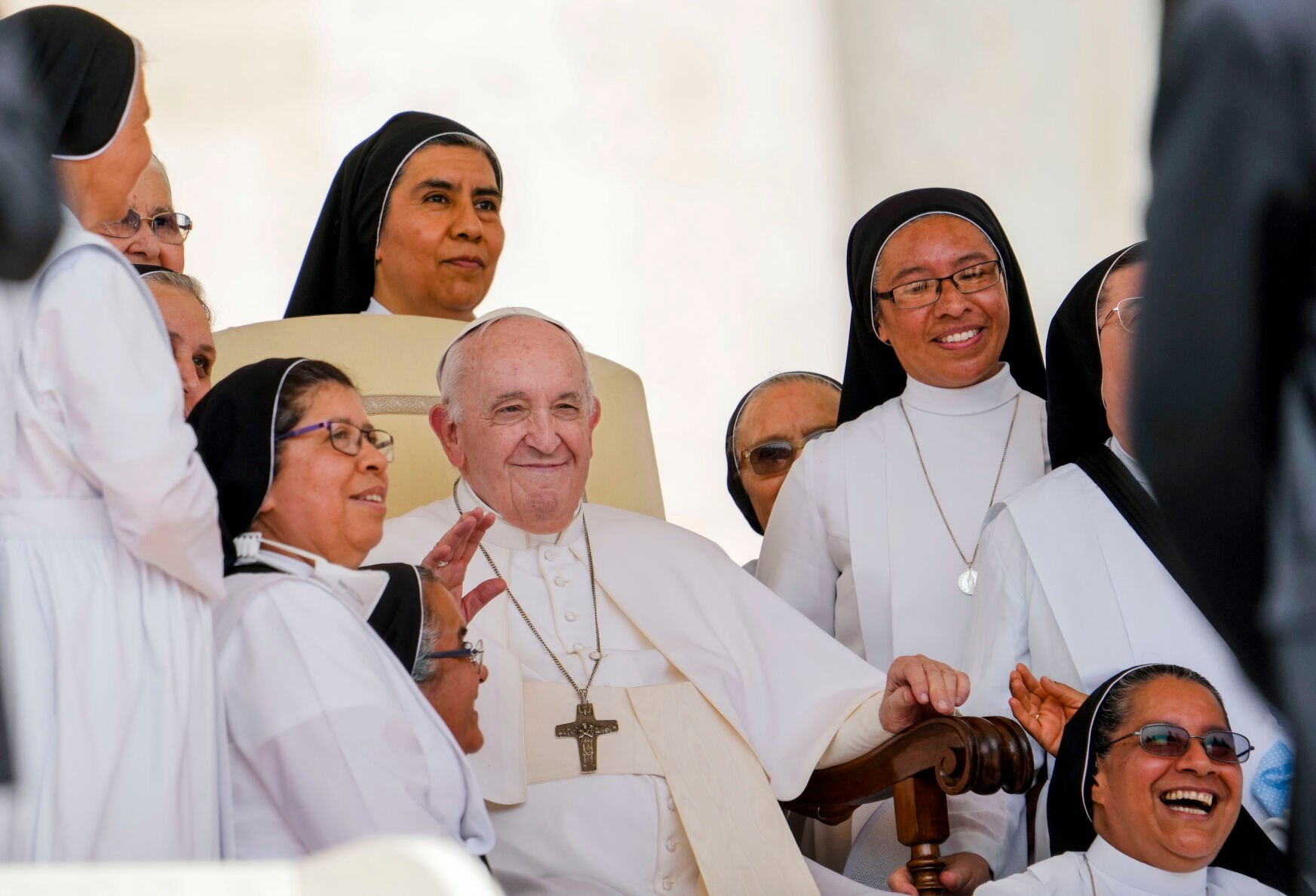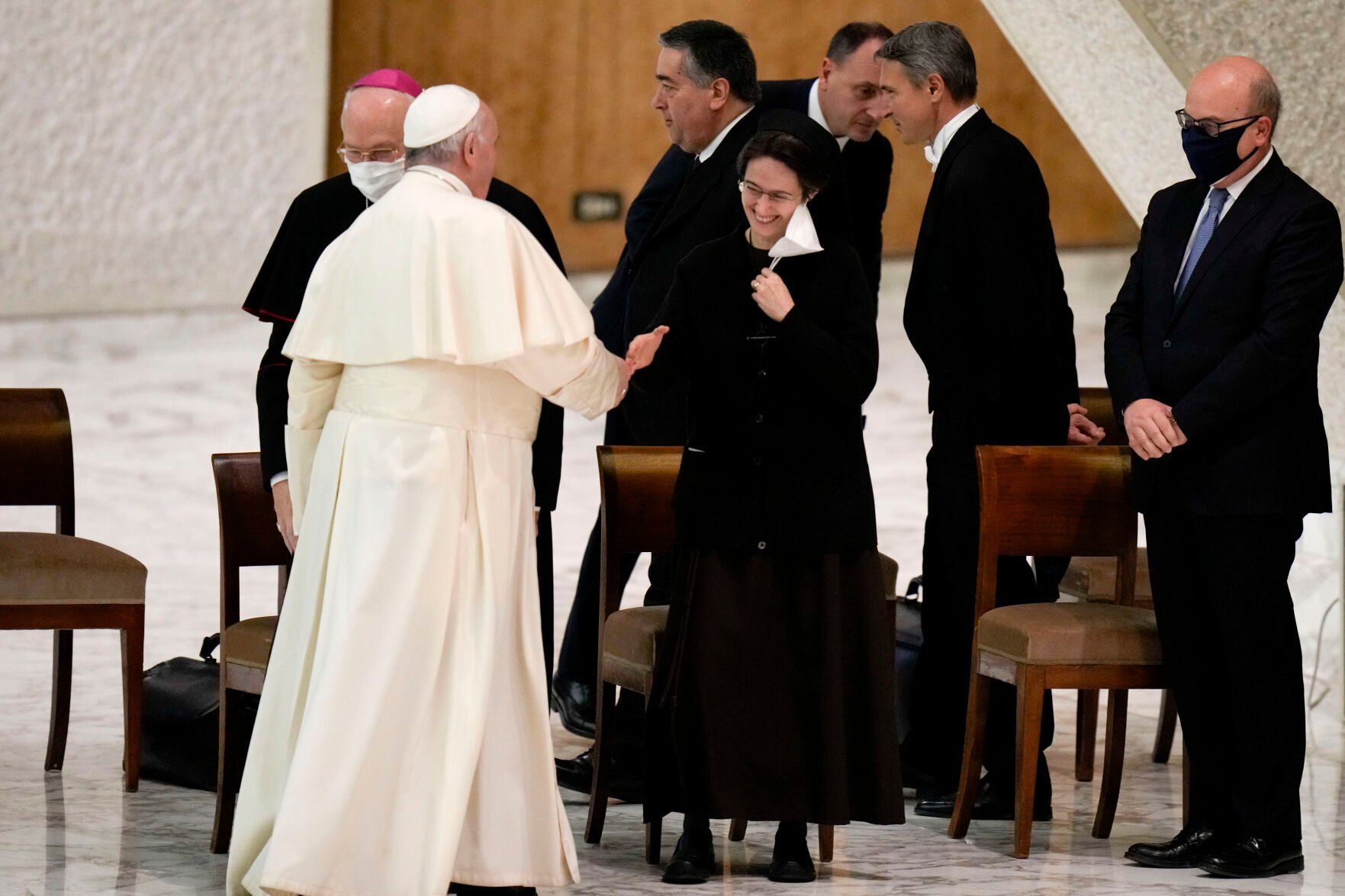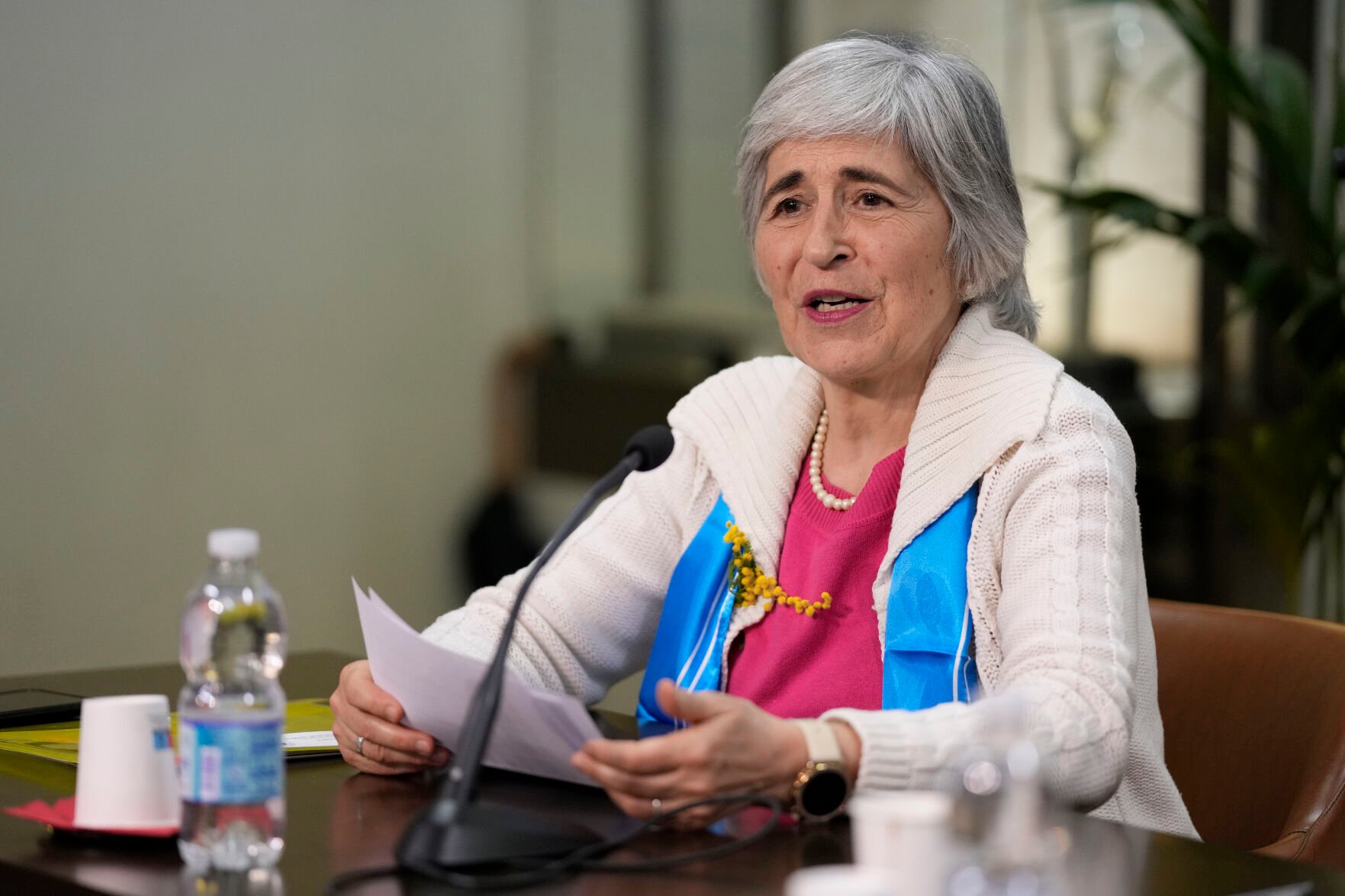VATICAN CITY — Pope Francis increased the Vatican’s female workforce, including in high-ranking positions, but women still face resistance from the all-male Catholic hierarchy to access leadership positions in the church, according to Vatican statistics and independent surveys released Wednesday.
The data was released as Francis marked International Women’s Day by thanking women “for their commitment to building a more humane society, through their ability to grasp reality with a creative eye and a tender heart.”

Andrew Medichini, Associated Press
Pope Francis poses for a photo with nuns June 22, 2022, at the end of his weekly general audience in St. Peter's Square at the Vatican.
Catholic women do the lion’s share of the church’s work in schools, hospitals and passing down the faith to future generations, but have long complained of a second-class status in an institution that reserves the priesthood for men.
Francis has overseen a marked increase in the number and percentage of women working at the Vatican in his 10 years as pope, from 19.3% in 2013 to 23.4% today, according to statistics reported by Vatican News.
In the Curia alone — the Holy See offices that actually run the universal Catholic Church — the percentage of women has now hit 26%, such that one in four employees is female.
And while no woman heads a Vatican office, more women hold top decision-making positions than at any time in the Vatican’s history.
Among them is Sister Raffaella Petrini, the first-ever female secretary general of the Vatican City State, responsible for the territory’s health care system, police force and main source of revenue: the Vatican Museums.

Alessandra Tarantino, Associated Press
Pope Francis shakes hands with Sister Raffaella Petrini as he arrives Dec. 23, 2021, for an audience with employees in the Paul VI Hall at the Vatican.
Petrini, a member of the Meriden, Conn.-based Franciscan Sisters of the Eucharist religious order, said Wednesday during a Women’s Day speech that her nomination raised eyebrows.
She acknowledged her philosophy of organizational leadership encountered some resistance, particularly within the Vatican’s old guard, but younger employees were more open to the collaborative teamwork she promotes.
“Even in non-ecclesial organizations, resistance is part of the process of change,” said Petrini, a professor of welfare economics at Rome’s Pontifical Angelicum University.
In addition to naming more women to the Vatican, Francis launched a multiyear consultative process about the church’s future that increasingly pointed to concrete demands by Catholic women for greater leadership and decision-making roles.
María Lía Zervino, president of the World Union of Catholic Women’s Organizations, said Francis’ consultative synod process was going a long way toward letting women’s voices be heard. She released preliminary results of a survey of female participants that found the majority believed they were listened to, even though obstacles remained.

Andrew Medichini, Associated Press
Maria Lia Zervino, president general of the World Union of Catholic Women's Organisations, addresses reporters Wednesday during a news conference to present the "Women's voices: global perspectives" international survey of Catholic women produced by researchers from Australia's University of Newcastle, in Rome.
Zervino, who along with Petrini was named by Francis as the first-ever female members of the Vatican’s Dicastery for Bishops last year, said 43% of the respondents identified “ordained ministers” as posing the greatest obstacle to the consultation process, evidence that clerics remained resistant to women’s full participation.
Another survey released Wednesday by researchers at the University of Newcastle, Australia, identified abuses of power and clericalism as barriers to women’s participation in the church, and found the vast majority of respondents to a non-random sampling of Catholic women supported women’s ordination to the priesthood and the ability to preach homilies at Mass.
Zervino said her own experience at the Vatican helping nominate bishops hadn’t run into clerical resistance. But she said it hadn’t been easy, either.
“In my life, I never thought I would be doing this,” she told a Women’s Day event at the Vatican, “and it requires a terribly big effort for me because I have to be at a high level that I’m still learning.”
She said her experience taught her that the church must train women to be leaders in the hierarchy, since those positions are now open to them thanks to Francis’ reforms.
“I thank the church for this, which is an important, wonderful step forward,” she said. “There is no possibility of going back.”
-
Pope bolsters women at Vatican but resistance remains
Gregorio Borgia
Pope Francis blesses one of the nineteen new priests that he ordained during a ceremony in St. Peter's Basilica at the Vatican, Sunday, April 26, 2015. (AP Photo/Gregorio Borgia)
Gregorio Borgia
Pope Francis blesses one of the nineteen new priests that he ordained during a ceremony in St. Peter's Basilica at the Vatican, Sunday, April 26, 2015. (AP Photo/Gregorio Borgia)
-
Pope bolsters women at Vatican but resistance remains
Massimo Pinca
FILE - In this June 21, 2015 file photo, Pope Francis salutes the faithful gathered outside the hospital Cottolengo of Turin, northern Italy. Italian tenor Andrea Bocelli, Colombian pop singer Juanes and the Philadelphia Orchestra are among the musical acts organizers say will perform for Pope Francis during his visits to the city this fall. World Meeting of Families organizers say Tuesday the singers and symphony orchestra will appear at the Festival of Families celebration Sept. 26 on the Benjamin Franklin Parkway in downtown Philadelphia. (AP Photo/Massimo Pinca, File)
Massimo Pinca
FILE - In this June 21, 2015 file photo, Pope Francis salutes the faithful gathered outside the hospital Cottolengo of Turin, northern Italy. Italian tenor Andrea Bocelli, Colombian pop singer Juanes and the Philadelphia Orchestra are among the musical acts organizers say will perform for Pope Francis during his visits to the city this fall. World Meeting of Families organizers say Tuesday the singers and symphony orchestra will appear at the Festival of Families celebration Sept. 26 on the Benjamin Franklin Parkway in downtown Philadelphia. (AP Photo/Massimo Pinca, File)
-
-
Pope bolsters women at Vatican but resistance remains
Pablo Martinez Monsivais
An unidentified child, who was carried out from the crowd to meet Pope Francis, reaches out to touch the Pontiff's face during a parade on his way to celebrate Sunday Mass on the Benjamin Franklin Parkway in Philadelphia, Sunday, Sept. 27, 2015. Pope Francis is in Philadelphia for the last leg of his six-day visit to the United States. (AP Photo/Pablo Martinez Monsivais)
Pablo Martinez Monsivais
An unidentified child, who was carried out from the crowd to meet Pope Francis, reaches out to touch the Pontiff's face during a parade on his way to celebrate Sunday Mass on the Benjamin Franklin Parkway in Philadelphia, Sunday, Sept. 27, 2015. Pope Francis is in Philadelphia for the last leg of his six-day visit to the United States. (AP Photo/Pablo Martinez Monsivais)
-
Pope bolsters women at Vatican but resistance remains
Uncredited
Pope Francis comforts a child during a brief, unscheduled stop at a pediatric hospital on his way to Bangui cathedral, Central African Republic, Sunday, Nov. 29, 2015. Pope Francis is in Africa for a six-day visit that is taking him to Kenya, Uganda and the Central African Republic. (L'Osservatore Romano/Pool Photo via AP)
Uncredited
Pope Francis comforts a child during a brief, unscheduled stop at a pediatric hospital on his way to Bangui cathedral, Central African Republic, Sunday, Nov. 29, 2015. Pope Francis is in Africa for a six-day visit that is taking him to Kenya, Uganda and the Central African Republic. (L'Osservatore Romano/Pool Photo via AP)
-
-
Pope bolsters women at Vatican but resistance remains
Andrew Medichini
Pope Francis waves to the crowd as he arrives on his pope-mobile for his weekly general audience, in St. Peter's Square at the Vatican, Wednesday, April 6, 2016. (AP Photo/Andrew Medichini)
Andrew Medichini
Pope Francis waves to the crowd as he arrives on his pope-mobile for his weekly general audience, in St. Peter's Square at the Vatican, Wednesday, April 6, 2016. (AP Photo/Andrew Medichini)
-
Pope bolsters women at Vatican but resistance remains
Osservatore Romano
Members of the Italian pop trio Il Volo (The Flight), Gianluca Ginoble, left, Ignazio Boschetto, center, and Piero Barone, right, present a record with their music to Pope Francis, during a private audience, at the Vatican, Saturday, May 6, 2017. (L'Osservatore Romano/Pool Photo via AP)
Osservatore Romano
Members of the Italian pop trio Il Volo (The Flight), Gianluca Ginoble, left, Ignazio Boschetto, center, and Piero Barone, right, present a record with their music to Pope Francis, during a private audience, at the Vatican, Saturday, May 6, 2017. (L'Osservatore Romano/Pool Photo via AP)
-
-
Pope bolsters women at Vatican but resistance remains
Alessandra Tarantino
Pope Francis rises the holy host during a Mass in San Pier Damiani parish church in Casal Bernocchi, in the outskirts of Rome, Sunday, May 21, 2017. (AP Photo/Alessandra Tarantino)
Alessandra Tarantino
Pope Francis rises the holy host during a Mass in San Pier Damiani parish church in Casal Bernocchi, in the outskirts of Rome, Sunday, May 21, 2017. (AP Photo/Alessandra Tarantino)
-
Pope bolsters women at Vatican but resistance remains
Andrew Medichini
Pope Francis kisses a baby as he arrives for his weekly general audience, at the Vatican, Wednesday, Sept. 27, 2017. (AP Photo/Andrew Medichini)
Andrew Medichini
Pope Francis kisses a baby as he arrives for his weekly general audience, at the Vatican, Wednesday, Sept. 27, 2017. (AP Photo/Andrew Medichini)
-
-
Pope bolsters women at Vatican but resistance remains
Andrew Medichini
Pope Francis' pastoral staff is hit by a ray of the sun during the canonization mass for 35 new saints in St. Peter's Square at the Vatican, Sunday, Oct.15, 2017. (AP Photo/Andrew Medichini)
Andrew Medichini
Pope Francis' pastoral staff is hit by a ray of the sun during the canonization mass for 35 new saints in St. Peter's Square at the Vatican, Sunday, Oct.15, 2017. (AP Photo/Andrew Medichini)
-
Pope bolsters women at Vatican but resistance remains
Andrew Medichini
Pope Francis delivers his speech during a meeting with Myanmar's leader Aung San Suu Kyi, at the International Convention Centre of Naypyitaw, Myanmar, Tuesday, Nov. 28, 2017. The pontiff is in Myanmar for the first stage of a week-long visit that will also take him to neighboring Bangladesh. (AP Photo/Andrew Medichini)
Andrew Medichini
Pope Francis delivers his speech during a meeting with Myanmar's leader Aung San Suu Kyi, at the International Convention Centre of Naypyitaw, Myanmar, Tuesday, Nov. 28, 2017. The pontiff is in Myanmar for the first stage of a week-long visit that will also take him to neighboring Bangladesh. (AP Photo/Andrew Medichini)
-
-
Pope bolsters women at Vatican but resistance remains
POOL
Pope Francis blows a candle on the occasion of his 81st birthday during a private audience with children the Paul VI hall at the Vatican, Sunday, Dec. 17, 2017. (L'Osservatore Romano/Pool Photo via AP)
POOL
Pope Francis blows a candle on the occasion of his 81st birthday during a private audience with children the Paul VI hall at the Vatican, Sunday, Dec. 17, 2017. (L'Osservatore Romano/Pool Photo via AP)
-
Pope bolsters women at Vatican but resistance remains
POOL
Pope Francis waves to faithful during the Urbi et Orbi (Latin for ' to the city and to the world') Christmas' day blessing from the main balcony of St. Peter's Basilica at the Vatican, Monday, Dec. 25, 2017. (L'Osservatore Romano/Pool Photo Via AP)
POOL
Pope Francis waves to faithful during the Urbi et Orbi (Latin for ' to the city and to the world') Christmas' day blessing from the main balcony of St. Peter's Basilica at the Vatican, Monday, Dec. 25, 2017. (L'Osservatore Romano/Pool Photo Via AP)
-
-
Pope bolsters women at Vatican but resistance remains
Rodrigo Abd
Pope Francis greets indigenous representatives in Puerto Maldonado, Peru, Friday, Jan. 19, 2018. Standing with thousands of indigenous Peruvians, Francis declared the Amazon the "heart of the church" and called for a three-fold defense of its life, land and cultures. (AP Photo/Rodrigo Abd)
Rodrigo Abd
Pope Francis greets indigenous representatives in Puerto Maldonado, Peru, Friday, Jan. 19, 2018. Standing with thousands of indigenous Peruvians, Francis declared the Amazon the "heart of the church" and called for a three-fold defense of its life, land and cultures. (AP Photo/Rodrigo Abd)
-
Pope bolsters women at Vatican but resistance remains
Divione Produzione Fotografica
Pope Francis washes the feet of inmates during his visit to the Regina Coeli detention center in Rome, Thursday, March 29, 2018, where he celebrated the "Missa in Coena Domini". Pope Francis visit to a prison on Holy Thursday to wash the feet of some inmates, stresses in a pre-Easter ritual that a pope must serve society's marginalized and give them hope. (Vatican Media via AP)
Divione Produzione Fotografica
Pope Francis washes the feet of inmates during his visit to the Regina Coeli detention center in Rome, Thursday, March 29, 2018, where he celebrated the "Missa in Coena Domini". Pope Francis visit to a prison on Holy Thursday to wash the feet of some inmates, stresses in a pre-Easter ritual that a pope must serve society's marginalized and give them hope. (Vatican Media via AP)
-
-
Pope bolsters women at Vatican but resistance remains
Andrew Medichini
Pope Francis smiles as he looks at a llama upon his arrival in St.Peter's Square at the Vatican for his weekly general audience, Wednesday, April 11, 2018. Three men from the South Tyrol region of northern Italy walked with three llamas in a two-month pilgrimage to reach the Vatican. (AP Photo/Andrew Medichini)
Andrew Medichini
Pope Francis smiles as he looks at a llama upon his arrival in St.Peter's Square at the Vatican for his weekly general audience, Wednesday, April 11, 2018. Three men from the South Tyrol region of northern Italy walked with three llamas in a two-month pilgrimage to reach the Vatican. (AP Photo/Andrew Medichini)
-
Pope bolsters women at Vatican but resistance remains
Andrew Medichini
Pope Francis twirls a soccer ball he was presented by a member of the Circus of Cuba, during his weekly general audience in the Pope Paul VI hall, at the Vatican, Wednesday, Jan. 2, 2019. (AP Photo/Andrew Medichini)
Andrew Medichini
Pope Francis twirls a soccer ball he was presented by a member of the Circus of Cuba, during his weekly general audience in the Pope Paul VI hall, at the Vatican, Wednesday, Jan. 2, 2019. (AP Photo/Andrew Medichini)
-
-
Pope bolsters women at Vatican but resistance remains
Kamran Jebreili
Pope Francis blesses a boy during a Mass at the Sheikh Zayed Sports City in Abu Dhabi, United Arab Emirates, Tuesday, Feb. 5, 2019. Francis travelled to Abu Dhabi to participate in a conference on inter religious dialogue sponsored the Emirates-based Muslim Council of Elders, an initiative that seeks to counter religious fanaticism by promoting a moderate brand of Islam. (AP Photo/Kamran Jebreili)
Kamran Jebreili
Pope Francis blesses a boy during a Mass at the Sheikh Zayed Sports City in Abu Dhabi, United Arab Emirates, Tuesday, Feb. 5, 2019. Francis travelled to Abu Dhabi to participate in a conference on inter religious dialogue sponsored the Emirates-based Muslim Council of Elders, an initiative that seeks to counter religious fanaticism by promoting a moderate brand of Islam. (AP Photo/Kamran Jebreili)
-
Pope bolsters women at Vatican but resistance remains
Andrew Medichini
Pope Francis holds up the holy host as he celebrates a Mass in front of St. Pancrazio Cathedral, in Albano, in the outskirts of Rome, Saturday, Sept. 21, 2019. (AP Photo/ Andrew Medichini)
Andrew Medichini
Pope Francis holds up the holy host as he celebrates a Mass in front of St. Pancrazio Cathedral, in Albano, in the outskirts of Rome, Saturday, Sept. 21, 2019. (AP Photo/ Andrew Medichini)
-
-
Pope bolsters women at Vatican but resistance remains
Eugene Hoshiko
Pope Francis caresses a child in Popemobile as he arrives for Holy Mass at Tokyo Dome Monday, Nov. 25, 2019, in Tokyo. (AP Photo/Eugene Hoshiko)
Eugene Hoshiko
Pope Francis caresses a child in Popemobile as he arrives for Holy Mass at Tokyo Dome Monday, Nov. 25, 2019, in Tokyo. (AP Photo/Eugene Hoshiko)
-
Pope bolsters women at Vatican but resistance remains
Alessandra Tarantino
Pope Francis greets a group of Mexican pilgrims in the Paul VI Hall at the Vatican during his weekly general audience, Wednesday, Dec. 11, 2019. (AP Photo/Alessandra Tarantino)
Alessandra Tarantino
Pope Francis greets a group of Mexican pilgrims in the Paul VI Hall at the Vatican during his weekly general audience, Wednesday, Dec. 11, 2019. (AP Photo/Alessandra Tarantino)
-
-
Pope bolsters women at Vatican but resistance remains
Alessandra Tarantino
Pope Francis gives the thumbs up as he leaves after his weekly general audience in the Paul VI Hall at the Vatican, Wednesday, Sept. 22, 2021. (AP Photo/Alessandra Tarantino)
Alessandra Tarantino
Pope Francis gives the thumbs up as he leaves after his weekly general audience in the Paul VI Hall at the Vatican, Wednesday, Sept. 22, 2021. (AP Photo/Alessandra Tarantino)
-
Pope bolsters women at Vatican but resistance remains
Andrew Medichini
Pope Francis salutes a group of nuns at the end of his weekly general audience in the Paul VI Hall the Vatican, Wednesday, Nov. 24, 2021. (AP Photo/Andrew Medichini)
Andrew Medichini
Pope Francis salutes a group of nuns at the end of his weekly general audience in the Paul VI Hall the Vatican, Wednesday, Nov. 24, 2021. (AP Photo/Andrew Medichini)



